Discover 35 hidden attractions, cool sights, and unusual things to do in Melbourne (Australia). Don't miss out on these must-see attractions: National Gallery of Victoria, ACMI, and Sea Life Melbourne Aquarium. Also, be sure to include Collins Street in your itinerary.
Below, you can find the list of the most amazing places you should visit in Melbourne (Victoria).
Table of Contents
National Gallery of Victoria
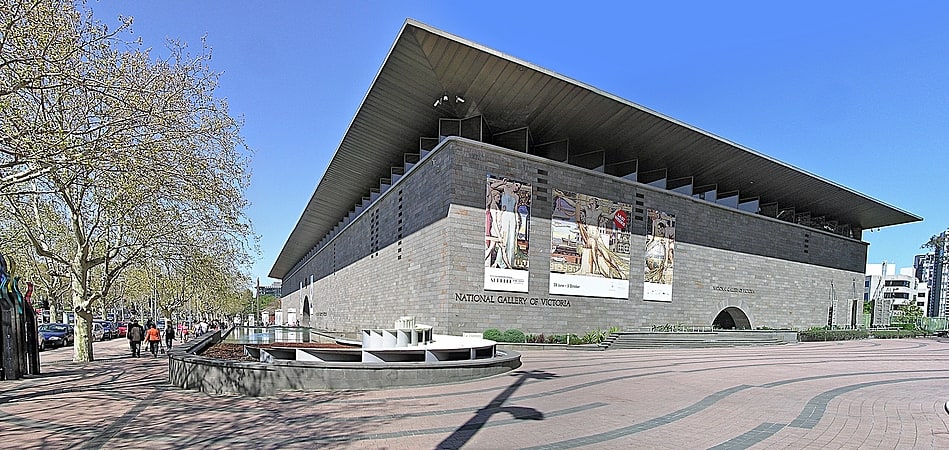
Australian and international art museum. The National Gallery of Victoria, popularly known as the NGV, is an art museum in Melbourne, Victoria, Australia. Founded in 1861, it is Australia's oldest and most visited art museum.
The NGV houses an encyclopedic art collection across two sites: NGV International, located on St Kilda Road in the Melbourne Arts Precinct of Southbank, and the Ian Potter Centre: NGV Australia, located nearby at Federation Square. The NGV International building, designed by Sir Roy Grounds, opened in 1968, and was redeveloped by Mario Bellini before reopening in 2003. It houses the gallery's international art collection and is on the Victorian Heritage Register.
The Ian Potter Centre: NGV Australia, designed by Lab Architecture Studio, opened in 2002 and houses the gallery's Australian art collection.
A third site, NGV Contemporary, is planned to open in 2028, and will be Australia's largest contemporary gallery.[1]
Address: 180 St Kilda Rd, 3006 Melbourne (City of Melbourne)
ACMI
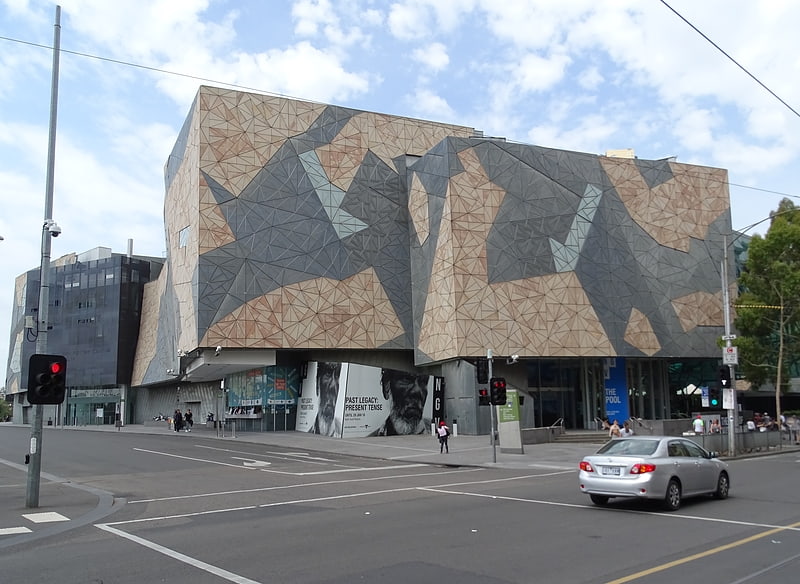
Museum in the City of Melbourne, Australia. ACMI, formerly the Australian Centre for the Moving Image, at Federation Square, Melbourne, is Australia's national museum of film, television, videogames, and art.
During the 2014-15 financial year, 1.3 million people visited ACMI, the second-highest attendance of any gallery or museum in Australia. In May 2019, ACMI closed to the public to begin a $40 million redevelopment.[2]
Address: Flinders St, 3000 Melbourne (City of Melbourne)
Sea Life Melbourne Aquarium

Exotic marine life and hands-on programs. Sea Life Melbourne Aquarium is a Southern Ocean and Antarctic aquarium in central Melbourne, Australia. It is located on the banks of the Yarra River beside and under the Flinders Street Viaduct and the King Street Bridge. The attraction is a Sea Life Centre owned by Merlin Entertainments.[3]
Address: King St, 3000 Melbourne (City of Melbourne)
Collins Street
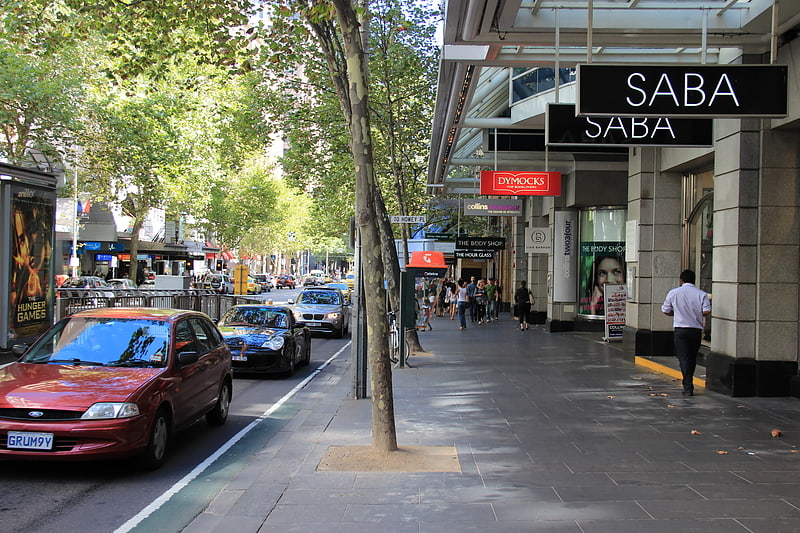
Street in Melbourne, Australia. Collins Street is a major street in the centre of Melbourne, Victoria, Australia. It was laid out in the first survey of Melbourne, the original 1837 Hoddle Grid, and soon became the most desired address in the city. Collins Street was named after Lieutenant-Governor of Tasmania David Collins who led a group of settlers in establishing a short-lived settlement at Sorrento in 1803.
The eastern end of Collins Street has been known colloquially as the 'Paris End' since the 1950s due to its numerous heritage buildings, old street trees, high-end shopping boutiques, and as the location for the first footpath cafes in the city. As with all main streets in the Melbourne city centre, the Hoddle Grid is exactly 99 feet wide which would allow for the installation of trams in 1885. Blocks further west centred around Queen Street became the financial heart of Melbourne in the 19th century, the preferred home of major banks and insurance companies, a tradition which continues today with the most prestigious office blocks and skyscrapers found along its length.[4]
Address: 333 Collins St, 3000 Melbourne (City of Melbourne)
Melbourne Central
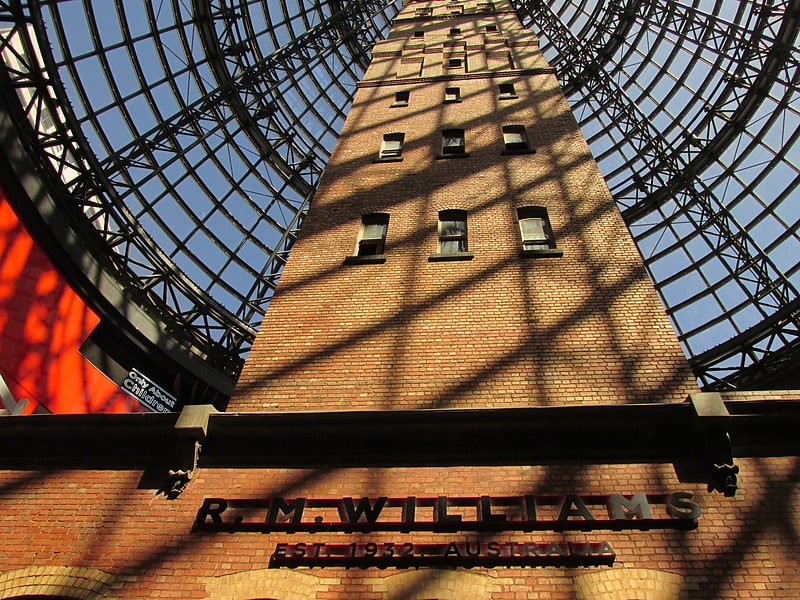
Shopping centre in the City of Melbourne, Australia. Melbourne Central is a large shopping centre, office, and public transport hub in the city of Melbourne, Victoria, Australia. The complex includes the Melbourne Central Shopping Centre, which was refurbished in 2005 by architects Ashton Raggatt McDougall; the Melbourne Central railway station; and the 211-metre high office tower with its distinctive black colour and two communications masts. The centre features a gross leasable area of 55,100 square metres. It is owned by GPT Group.[5]
Address: 211 La Trobe St, 3000 Melbourne (City of Melbourne)
Queen Victoria Market
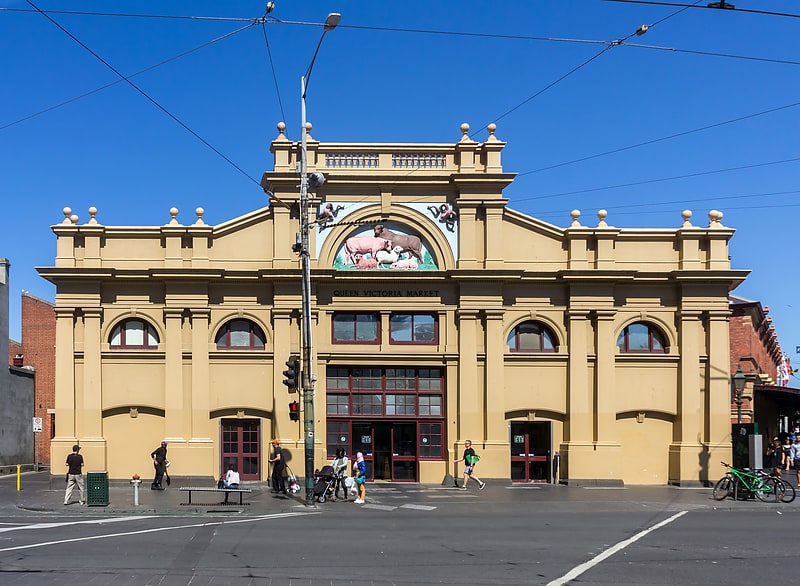
Shops and stalls in a historic venue. The Queen Victoria Market is a major landmark in the central business district of Melbourne, Victoria, Australia. Covering over seven hectares, it is the largest open air market in the Southern Hemisphere.
Constructed in stages from the 1860s and officially opened in 1878, the Queen Victoria Market is the last remaining major market in the CBD, and along with Prahran Market and South Melbourne Market, the last of the city's Victorian era markets still operating. It is listed on both the Victorian Heritage Register and the National Heritage List, and is one of Melbourne's major tourist sites, attracting approximately 10 million visitors annually.[6]
Address: Queen St, 3000 Melbourne (City of Melbourne)
Shrine of Remembrance
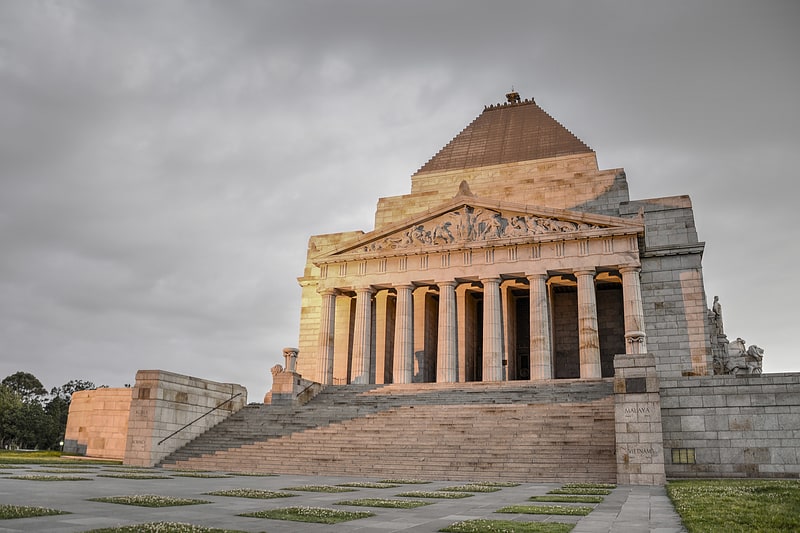
World War I shrine and memorial complex. The Shrine of Remembrance is a war memorial in Melbourne, Victoria, Australia, located in Kings Domain on St Kilda Road. It was built to honour the men and women of Victoria who served in World War I, but now functions as a memorial to all Australians who have served in any war. It is a site of annual observances for Anzac Day and Remembrance Day, and is one of the largest war memorials in Australia.
Designed by architects Phillip Hudson and James Wardrop, both World War I veterans, the Shrine is in classical style, based on the Tomb of Mausolus at Halicarnassus and the Parthenon in Athens, Greece. The crowning element at the top of the ziggurat roof references the Choragic Monument of Lysicrates. Built from Tynong granite, the Shrine originally consisted only of the central sanctuary surrounded by the ambulatory. The sanctuary contains the marble Stone of Remembrance, upon which is engraved the words "Greater love hath no man" (John 15:13); once per year, on 11 November at 11 a.m. (Remembrance Day), a ray of sunlight shines through an aperture in the roof to light up the word "Love" in the inscription. Beneath the sanctuary lies the crypt, which contains a bronze statue of a soldier father and son, and panels listing every unit of the Australian Imperial Force.
The Shrine went through a prolonged process of development, which began in 1918 with an initial proposal to build a Victorian memorial. Two committees were formed, the second of which ran a competition for the memorial's design. The winner was announced in 1922. However, opposition to the proposal, led by Keith Murdoch and the Herald Sun, forced the governments of the day to rethink the design. A number of alternatives were proposed, the most significant of which was the Anzac Square and cenotaph proposal of 1926. In response, General Sir John Monash used the 1927 Anzac Day march to garner support for the Shrine, and finally won the support of the Victorian government later that year. The foundation stone was laid on 11 November 1927, and the Shrine was officially dedicated on 11 November 1934.[7]
Address: Birdwood Ave, 3004 Melbourne (City of Melbourne)
Melbourne Zoo
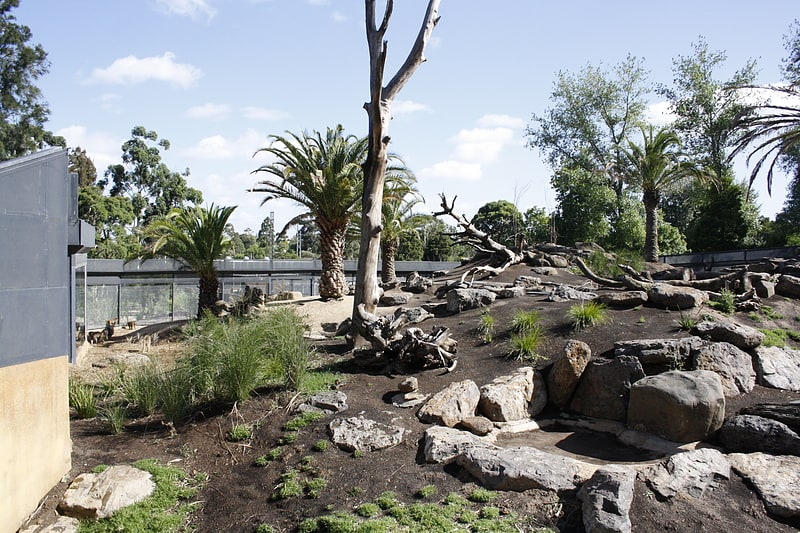
Victorian-era zoo with over 320 species. Melbourne Zoo is a zoo in Melbourne, Australia. It is located within Royal Park in Parkville, approximately 4 kilometres north of the centre of Melbourne. It is the primary zoo serving Melbourne. The zoo contains more than 320 animal species from Australia and around the world, and is accessible via Royal Park station on the Upfield railway line, and is also accessible via tram routes 58 and 19, as well as by bicycle on the Capital City Trail. Bicycles are not allowed inside the zoo itself.
The Royal Melbourne Zoological Gardens is a full institutional member of the Zoo and Aquarium Association (ZAA) and the World Association of Zoos and Aquariums (WAZA).[8]
Address: Elliott Ave, 3052 Parkville (City of Melbourne)
Royal Exhibition Building
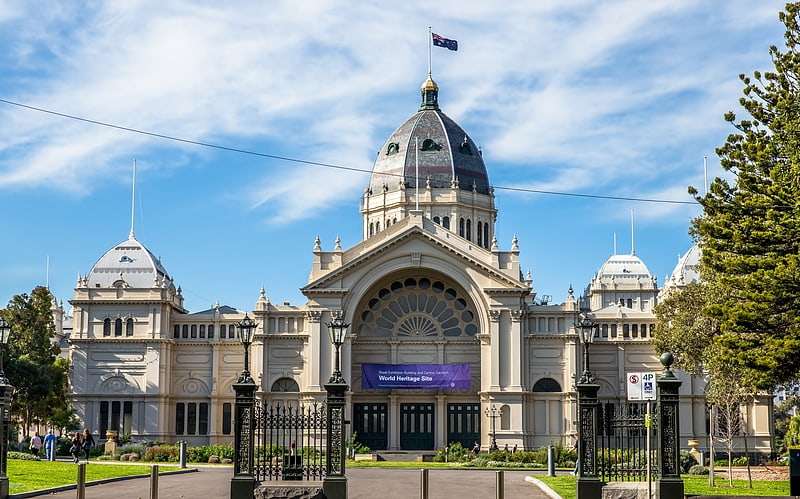
Iconic Victorian centre for events. The Royal Exhibition Building is a World Heritage-listed building in Melbourne, Victoria, Australia, built in 1879–1880 as part of the international exhibition movement, which presented over 50 exhibitions between 1851 and 1915 around the globe. The building sits on approximately 26 hectares, is 150 metres long and is surrounded by four city streets. It is at 9 Nicholson Street in the Carlton Gardens, flanked by Victoria, Carlton and Rathdowne Streets, at the north-eastern edge of the central business district. It was built to host the Melbourne International Exhibition in 1880–81, and then hosted the even larger Centennial International Exhibition in 1888, and the formal opening of the first Parliament of Australia in 1901. The building is representative of the money and pride Victoria had in the 1870s. Throughout the 20th century smaller sections and wings of the building were subject to demolition and fire; however, the main building, known as the Great Hall, survived.
It received restoration throughout the 1990s and in 2004 became the first building in Australia to be awarded UNESCO World Heritage status, being one of the last remaining major 19th-century exhibition buildings in the world. It is the world's most complete surviving site from the International Exhibition movement 1851–1914. It sits adjacent to the Melbourne Museum and is the largest item in Museum Victoria's collection. Today, the building hosts various exhibitions and other events and is closely tied with events at the Melbourne Museum.[9]
Address: 9 Nicholson St, 3053 Melbourne (City of Melbourne)
Carlton Gardens
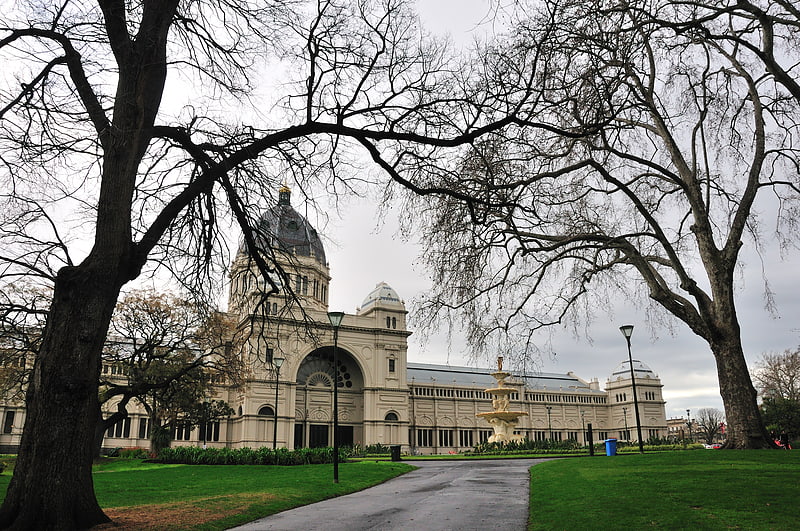
Historic Victorian-era park with museums. The Carlton Gardens is a World Heritage Site located on the northeastern edge of the Central Business District in the suburb of Carlton, in Melbourne, Australia. A popular picnic and barbecue area, the heritage-listed Carlton Gardens are home to an array of wildlife, including brushtail possums.
The 26-hectare (64-acre) site contains the Royal Exhibition Building, Melbourne Museum and Imax Cinema, tennis courts and an award-winning children's playground. The rectangular site is bound by Victoria Street, Rathdowne Street, Carlton Street, and Nicholson Street. From the Exhibition building the gardens gently slope down to the southwest and northeast. According to the World Heritage listing the Royal Exhibition Buildings and Carlton Gardens are "of historical, architectural, aesthetic, social and scientific (botanical) significance to the State of Victoria."
The gardens are an example of Victorian landscape design with sweeping lawns and varied European and Australian tree plantings consisting of deciduous English oaks, White Poplar, plane trees, elms, conifers, cedars, turkey oaks, Araucarias and evergreens such as Moreton Bay figs, combined with flower beds of annuals and shrubs. A network of tree-lined paths provides formal avenues for highlighting the fountains and architecture of the Exhibition building. This includes the grand allee of plane trees that lead to the exhibition building. Two small ornamental lakes adorn the southern section of the park. The northern section contains the museum, tennis courts, maintenance depot and curator's cottage, and the children's playground designed as a Victorian maze. Dramatic tree-lined avenues, a majestic fountain, formal flowerbeds and miniature lakes are features of these late nineteenth century Gardens.
The listing in the Victorian Heritage Register says in part:
"The Carlton Gardens are of scientific (botanical) significance for their outstanding collection of plants, including conifers, palms, evergreen and deciduous trees, many of which have grown to an outstanding size and form. The elm avenues of Ulmus procera and Ulmus × hollandica are significant as few examples remain world wide due to Dutch elm disease. The Garden contains a rare specimen of Acmena ingens, only five other specimens are known, an uncommon Harpephyllum caffrum and the largest recorded in Victoria, Taxodium distichum, and outstanding specimens of Chamaecyparis funebris and Ficus macrophylla, south west of the Royal Exhibition Building."Wildlife includes brushtailed possums, ducks and ducklings in spring, tawny frogmouths, kookaburras. Indian mynas and silver gulls are common. At night Gould's wattled bat and white-striped freetail bats hunt for insects while grey-headed flying foxes visit the gardens when native trees are flowering or fruiting.
The gardens contain three important fountains: the Exhibition Fountain, designed for the 1880 Exhibition by sculptor Joseph Hochgurtel; the French Fountain; and the Westgarth Drinking Fountain.
The grounds adjoining the north of the Exhibition Building formerly contained a sports ground, known as the Exhibition Oval or Exhibition Track. A fifth-of-a-mile oval asphalt cycling track was built in 1890, then was refurbished in 1896 to improve the surface and widen and bank the corners. The circuit held cycling races until the 1920s, as well as low-powered motorcycle races. The cycling track was removed in 1928, and replaced with a dirt track for high-powered motorcycle racing, which was growing in popularity at the time. A new seventh-of-a-mile banked oval board track was constructed in its place in 1936, but was removed in 1939 after the Supreme Court ruled that the track contravened the Exhibition Act, which required that the public have free access to the grounds; the track itself was moved to Napier Park, Essendon. Throughout its existence, the grassed oval in the middle of the racing tracks was used for various field sports events and carnivals, and at one point during a 1931 dispute between the Victorian Football League and its Grounds Management Association, the oval was on stand-by to serve as a VFL venue during the 1931 season. The gardens including the Exhibition Building and the fountains are now a popular spot for wedding photography.[10]
Address: 1-111 Carlton St, 3053 Melbourne (City of Melbourne)
Melbourne Museum
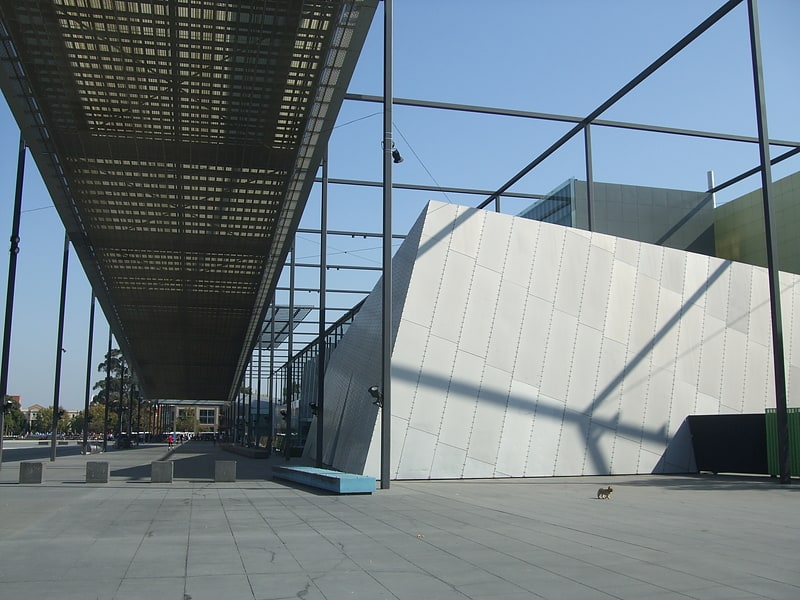
Natural history and cultural collections. The Melbourne Museum is a natural and cultural history museum located in the Carlton Gardens in Melbourne, Australia.
Located adjacent to the Royal Exhibition Building, the museum was opened in 2000 as a project of the Government of Victoria, on behalf of Museums Victoria which administers the venue.
The museum won the Best Tourist Attraction award at the Australian Tourism Awards in 2011.
In addition to its galleries, the museum features spaces such as Curious?, which is a place to meet staff and find answers relating to the collections, research and behind-the-scenes work of Museums Victoria; as well as a cafe and a gift shop. The back-of-house area houses some of the Victoria's State Collections, which holds over 17 million items, including objects relating to Indigenous Australian and Pacific Islander cultures, geology, historical studies, palaeontology, technology and society, and zoology, as well as a library collection that holds 18th and 19th century scientific monographs and serials. The world's largest IMAX theatre screen, which is also part of the museum complex, shows movies and documentary films in large-screen 3-D format.[11]
Address: 11 Nicholson St, 3053 Carlton (City of Melbourne)
Federation Square
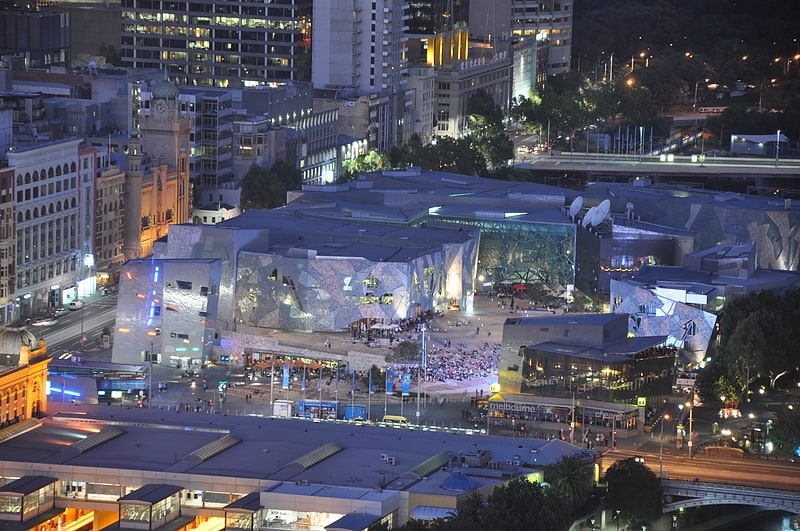
Contemporary central public space. Federation Square is a venue for arts, culture and public events on the edge of the Melbourne central business district. It covers an area of 3.2 ha at the intersection of Flinders and Swanston Streets built above busy railway lines and across the road from Flinders Street station. It incorporates major cultural institutions such as the Ian Potter Centre, Australian Centre for the Moving Image and the Koorie Heritage Trust as well as cafes and bars in a series of buildings centred around a large paved square, and a glass walled atrium.[12]
Address: 2 Swanston St, 3000 Melbourne (City of Melbourne)
St Paul's Cathedral
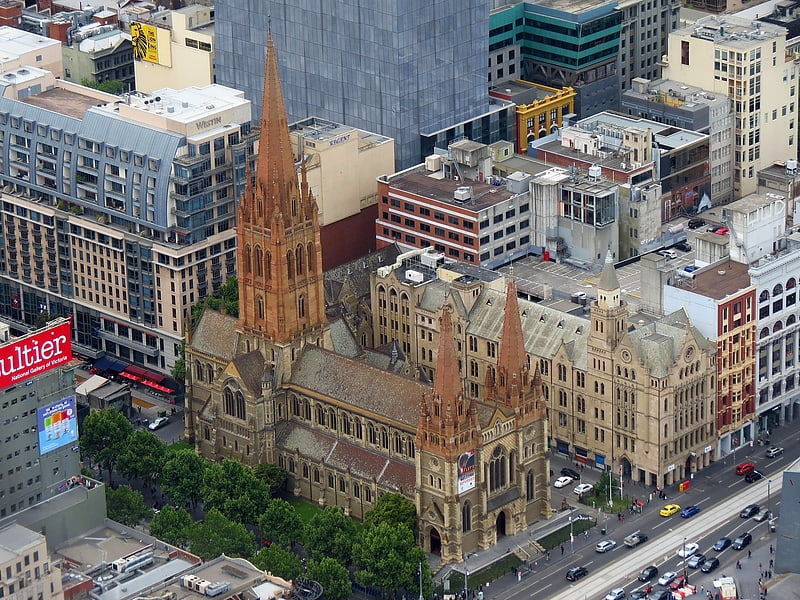
19th-century, neo-Gothic cathedral. St Paul's Cathedral is an Anglican cathedral in Melbourne, Australia. It is the cathedral church of the Diocese of Melbourne and the seat of the Archbishop of Melbourne, who is also the metropolitan archbishop of the Province of Victoria.
The cathedral was designed by the English Gothic Revival architect William Butterfield and completed in 1891, except for the spires which were built to a different design from 1926 to 1932. It is one of Melbourne's major architectural landmarks.[13]
Address: Cnr Flinders and Swanston Sts, Melbourne (City of Melbourne)
Heide Museum of Modern Art
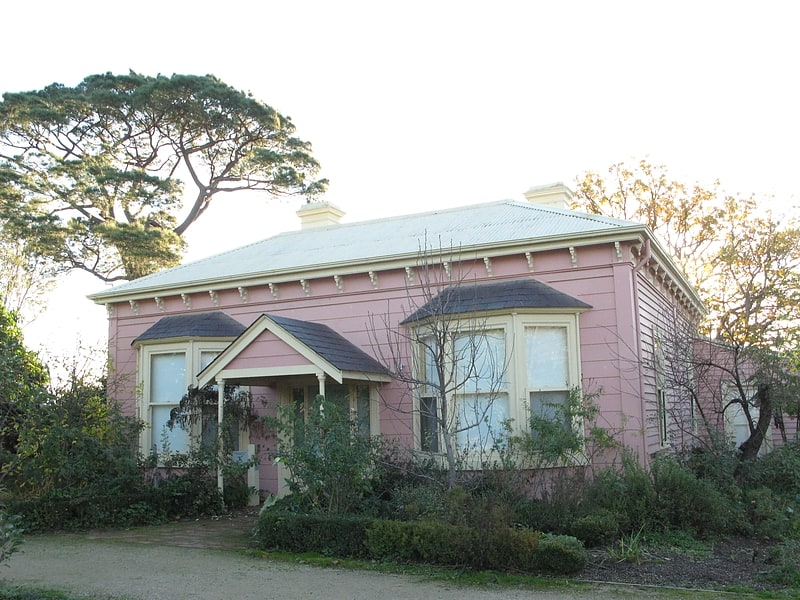
Museum in Bulleen, Australia. The Heide Museum of Modern Art, also known as Heide, is an art museum in Bulleen, a suburb of Melbourne, Victoria, Australia. Established in 1981, the museum houses modern and contemporary art across three distinct exhibition buildings and is set within sixteen acres of heritage-listed gardens and a sculpture park.
The museum occupies the site of a former dairy farm owned by prominent arts benefactors John and Sunday Reed. After purchasing the farm in 1934, they named it Heide in reference to the Heidelberg School, an impressionist art movement that developed in nearby Heidelberg in the 1880s. Heide became the gathering place for a collective of young modernist painters known as the Heide Circle, which included Sidney Nolan, John Perceval, Albert Tucker and Joy Hester, who often stayed in the Reeds' 19th-century farmhouse, now known as Heide I. Today they rank among Australia's best-known artists and are also considered leaders of the Angry Penguins, a modernist art movement named after a cultural journal co-published by the Reeds and poet Max Harris. Heide's close relationship to this movement is evidenced in many of its displays.
Between 1964 and 1967, the Reeds built a new residence, Heide II, now considered one of the finest examples of modernist architecture in Victoria. In 1980, after several years of negotiations, the Reeds sold Heide II, most of the adjoining property and significant works from their art collection to the Victorian Government for the establishment of a public art museum and park. The museum has since expanded its collection through many individual gifts, and in keeping with the Reeds' original aim, continues to support young and emerging artists.
In 1993, Heide III, a new purpose-built gallery building designed by Andrew Andersons, was added to the Heide complex. This building was extended when Heide underwent major redevelopments in 2005–06. Also during this period, the Sidney Myer Education Centre was built, Heide II and the surrounding gardens were restored, and new facilities were constructed.[14]
Address: 7 Templestowe Rd, 3105 Bulleen (Manningham)
Block Arcade
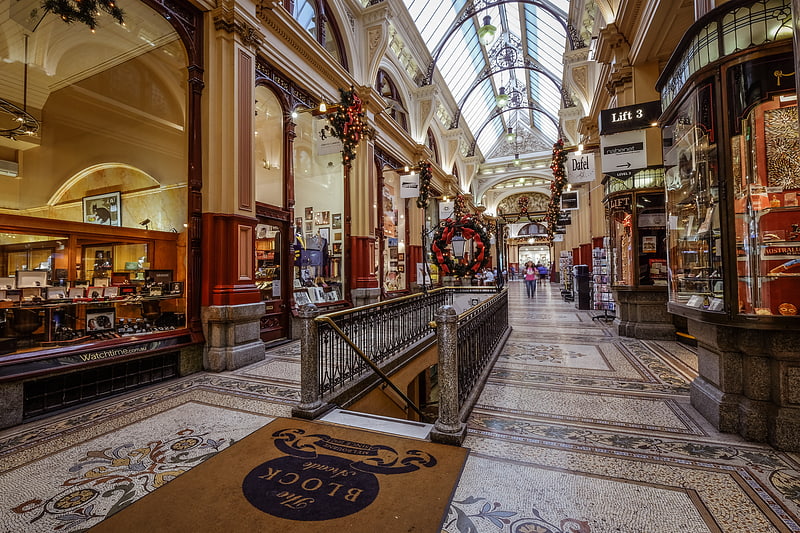
Arcade in the City of Melbourne, Australia. The Block Arcade is an historic shopping arcade in the central business district of Melbourne, Victoria, Australia. Constructed between 1891 and 1893, it is considered one of the late Victorian era's finest shopping arcades and ranks among Melbourne's most popular tourist attractions.
Designed by architects Twentyman & Askew, the Block is one of Melbourne's most richly decorated interior spaces, replete with mosaic tiled flooring, glass canopy, wrought iron and carved stone finishings. The arcade is L-shaped with an octagonal rotunda at the corner, connecting Collins Street at the south end to Elizabeth Street on the west. On the north side, the arcade connects to Block Place, a covered pedestrian lane that leads to Little Collins Street, opposite Melbourne's oldest shopping arcade, the Royal Arcade. The Block Arcade's six-storey external façades on both Collins and Elizabeth streets are some of Australia's best surviving examples of Victorian architecture in the Mannerist style.
The arcade takes its name from the practice of "doing the block": dressing fashionably and promenading the section of Collins Street between Elizabeth and Swanston streets. It is listed on the Victorian Heritage Register.[15]
Address: Melbourne, 282 Collins Street
Eureka Skydeck 88
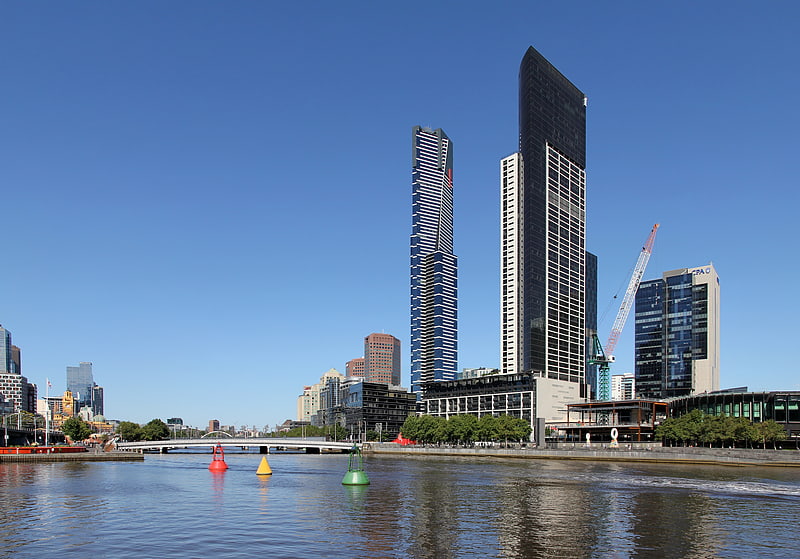
Skyscraper in Southbank, Australia. Eureka Tower is a 297.3 m skyscraper located in the Southbank precinct of Melbourne, Victoria, Australia. Construction began in August 2002 and the exterior was completed on 1 June 2006. The plaza was finished in June 2006 and the building was officially opened on 11 October 2006. The project was designed by Melbourne architectural firm Fender Katsalidis Architects and was built by Grocon. The developer of the tower was Eureka Tower Pty Ltd, a joint venture consisting of Daniel Grollo, investor Tab Fried and one of the Tower's architects Nonda Katsalidis. It was the world's tallest residential tower when measured to its highest floor, until surpassed by Ocean Heights and the HHHR Tower in Dubai. From 2006 to 2019, it was the tallest building in Melbourne, until the topping out of Australia 108. It is currently the third tallest building in Australia, behind the Q1 in Queensland and Australia 108, as well as the second tallest to roof behind the latter skyscraper. As of 2016 it was the 15th tallest residential building in the world.[16]
Address: 70 City Rd, 3006 Southbank (City of Melbourne)
Birrarung Marr

Park in the City of Melbourne, Australia. Birrarung Marr is an inner-city park between the central business district in Melbourne, Victoria, Australia and the Yarra River. It was opened in 2002. The name refers to the bank of Birrarung, the 'river of mists', in the Woiwurrung language of the Wurundjeri people, the Indigenous inhabitants at the time of European colonisation of the Melbourne area.[17]
Address: Batman Avenue, 3000 Melbourne (City of Melbourne)
Koorie Heritage Trust
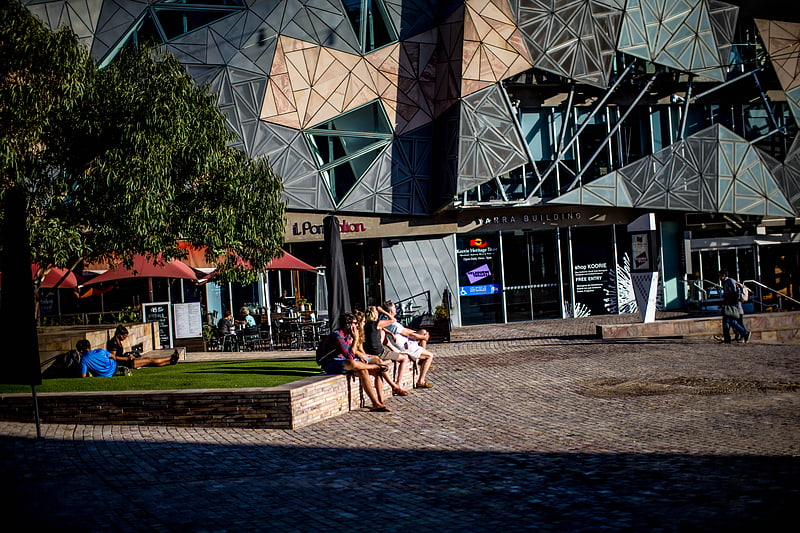
The Koorie Heritage Trust is an Indigenous not-for-profit cultural organisation based in Melbourne. It holds over 100,000 items in its collection from paintings and artefacts through to books, videos and photographs. It has "...a commitment to protect, preserve and promote the living culture of the Indigenous people of south-east Australia." The Koorie Heritage Trust also runs a variety of cultural educational programs and a Koorie family history service.[18]
Maling Road
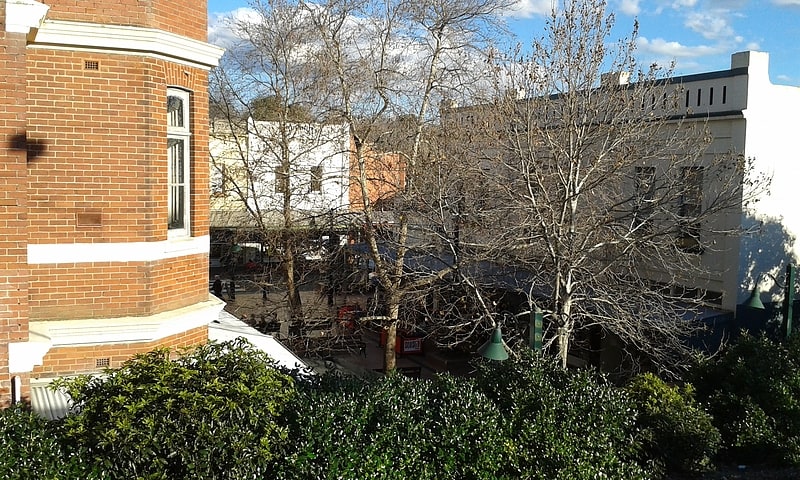
Road in Canterbury, Australia. Maling Road is a popular shopping strip in Canterbury, Victoria, Australia. It contains over fifty Edwardian-style shops in a pseudo-village setting. Its location was chosen due to its proximity to Canterbury railway station.[19]
Address: 145 Maling Rd, 3126 Canterbury (Boroondara)
Royal Botanic Gardens
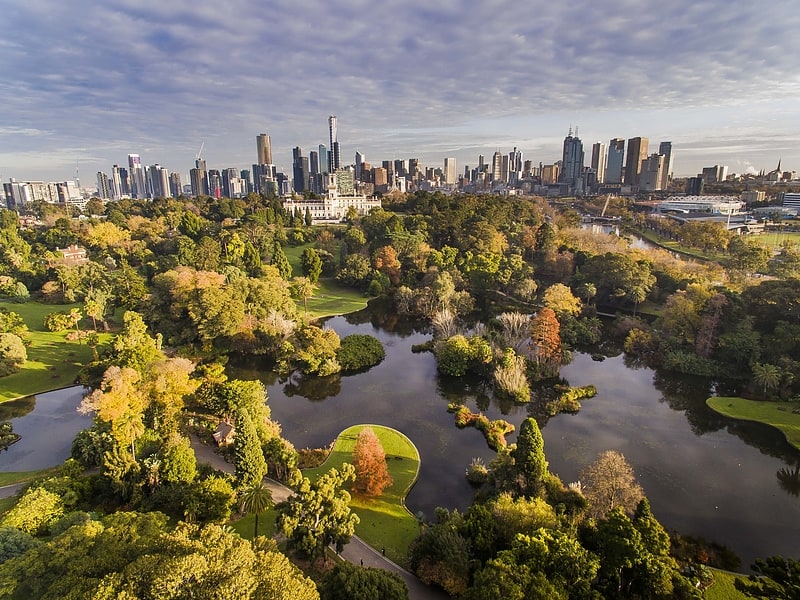
Riverside mix of native and exotic plants. Royal Botanic Gardens Victoria are botanic gardens across two sites–Melbourne and Cranbourne.
Melbourne Gardens was founded in 1846 when land was reserved on the south side of the Yarra River for a new botanic garden. It extends across 38 hectares (94 acres) that slope to the river with trees, garden beds, lakes and lawns. It displays almost 50,000 individual plants representing 8,500 different species. These are displayed in 30 living plant collections.
Cranbourne Gardens was established in 1970 when land was acquired by the Gardens on Melbourne's south-eastern urban fringe for the purpose of establishing a garden dedicated to Australian plants. A generally wild site that is significant for biodiversity conservation, it opened to the public in 1989. On the 363 hectares (897 acres) site, visitors can explore native bushland, heathlands, wetlands and woodlands. One of the features of Cranbourne is the Australian Garden, which celebrates Australian landscapes and flora through the display of approximately 170,000 plants from 1,700 plant varieties. It was completed in 2012.
Royal Botanic Gardens Victoria is home to the State Botanical Collection, which is housed in the National Herbarium of Victoria. The collection, which includes 1.5 million preserved plants, algae and fungi, represents the largest herbarium collection in Australia and wider Oceania. It also includes Australia's most comprehensive botanical library.[20]
Princes Bridge
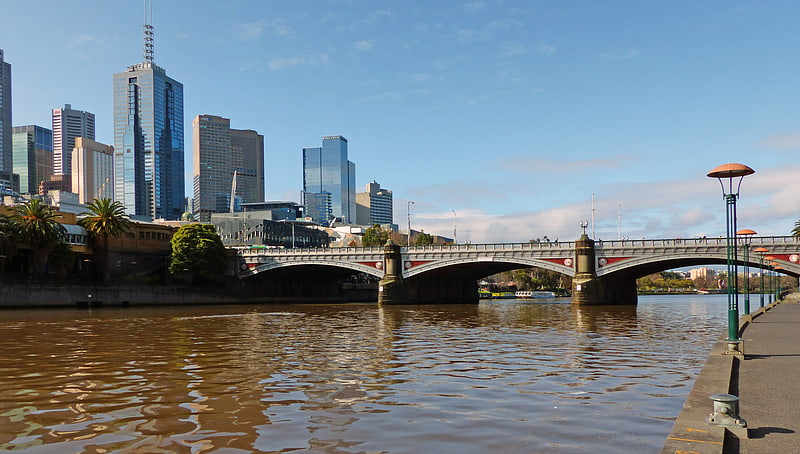
Arch bridge in the City of Melbourne, Australia. Princes Bridge, originally Prince's Bridge, is a bridge in central Melbourne, Australia that spans the Yarra River. It is built on the site of one of the oldest river crossings in the city, and forms a gateway into the central city from the south. The bridge connects Swanston Street on the north bank of the Yarra River to St Kilda Road on the south bank, and carries road, tram and pedestrian traffic. The present bridge was built in 1888 and is listed on the Victorian Heritage Register.
Because of its position, Princes Bridge is often a focal point for celebratory events in Melbourne such as the Moomba Festival, New Year's Eve and many celebrations taking place on the Yarra River where it flows through the city.[21]
Address: St Kilda Road, 3000 Southbank (City of Melbourne)
Werribee Open Range Zoo
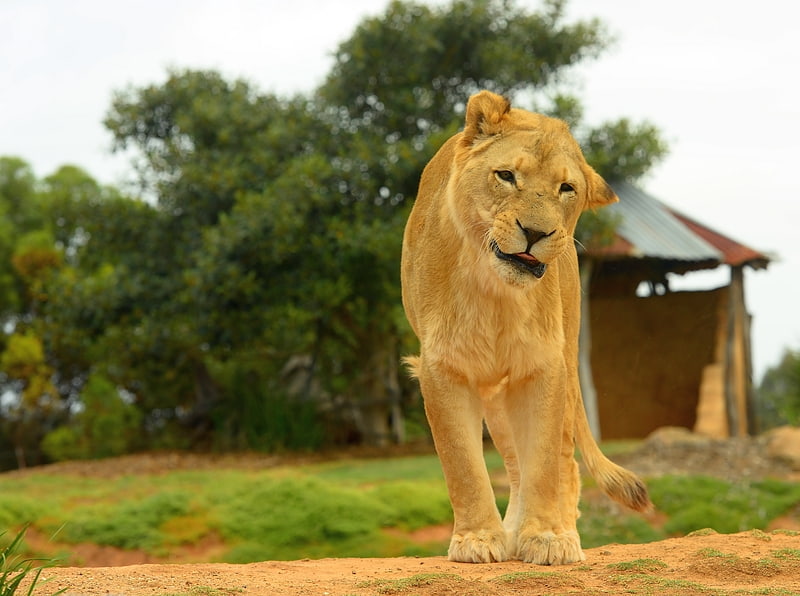
Zoo in Australia. Werribee Open Range Zoo is an African themed zoo in Werribee, about 32 kilometres south-west of Melbourne, Victoria, Australia. It is part of the Zoological Parks and Gardens Board or Zoos Victoria which also includes Melbourne Zoo and Healesville Sanctuary. It is situated on approximately 225 hectares and is located on the Werribee River in Werribee Park, adjacent to the Werribee Mansion. It was originally agistment land to the Melbourne Zoo.[22]
Address: K Road, 3030 Werribee (Wyndham)
Cooks' Cottage
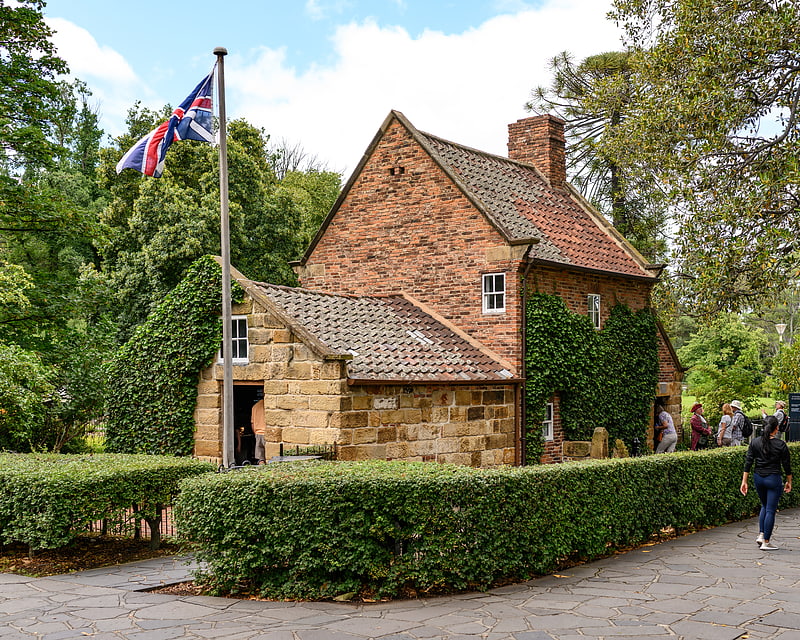
Historic home of James Cook's family. Cooks' Cottage, previously known as Captain Cook's Cottage, is located in the Fitzroy Gardens, Melbourne, Australia. The cottage was constructed in 1755 in the English village of Great Ayton, North Yorkshire, by the parents of Captain James Cook, James and Grace Cook, and was brought to Melbourne in 1934 by Sir Russell Grimwade. It is a point of conjecture among historians whether James Cook, the famous navigator, ever lived in the house, but almost certainly he visited his parents at the house.
The inside of the cottage includes centuries-old antiques and is stylised in the way of the 18th century, as are the clothes of the volunteer guides.[23]
Address: Fitzroy Gardens, 3002 Melbourne (City of Melbourne)
Greensborough Plaza
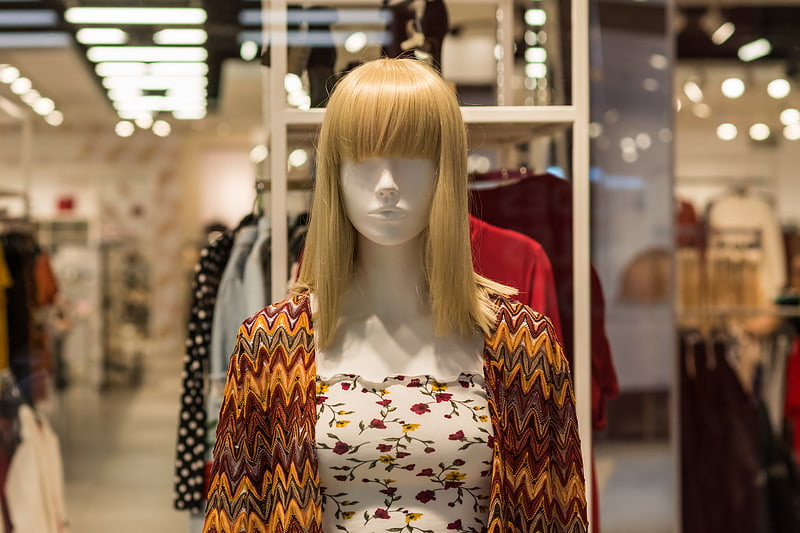
Shopping centre in Greensborough, Australia. Greensborough Plaza is a major regional shopping centre located in the north-eastern suburb of Greensborough in Melbourne, Victoria, Australia, approximately 20 kms from the CBD.
There is an extensive range of majors and mini-majors including Coles, Aldi, Kmart, Target, Chemist Warehouse, JB Hi-Fi Home, The Reject Shop, Rebel Sport, Anytime Fitness and Hoyts Cinemas.
With over 170 Specialty stores, the centre also has a Fresh Food and Dining and Entertainment precinct.[24]
Address: Greensborough Plaza 25 Main St, 3088 Melbourne (Banyule)
St Patrick's Cathedral
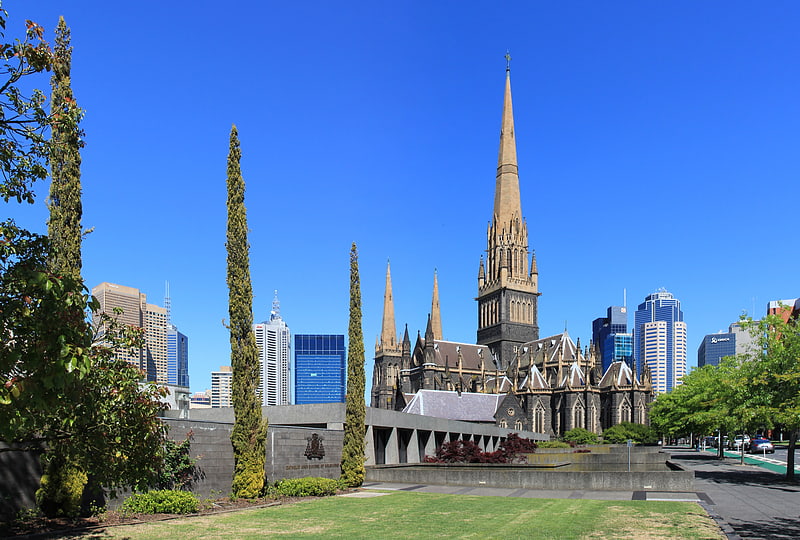
Vast 19th-century Gothic cathedral. The Cathedral Church and Minor Basilica of Saint Patrick is the cathedral church of the Roman Catholic Archdiocese of Melbourne in Victoria, Australia, and seat of its archbishop, currently Peter Comensoli.
In 1974 Pope Paul VI conferred the title and dignity of minor basilica on it. In 1986 Pope John Paul II visited the cathedral and addressed clergy during his Papal Visit.
The cathedral is built on a traditional east–west axis, with the altar at the eastern end, symbolising belief in the resurrection of Christ. The plan is in the style of a Latin cross, consisting of a nave with side aisles, transepts with side aisles, a sanctuary with seven chapels, and sacristies. Although its 103.6-metre (340 ft) length is marginally shorter than that of St Mary's Cathedral, Sydney, St Patrick's has the distinction of being both the tallest and, overall, the largest church building in Australia.[25]
Address: 1 Cathedral Pl, 3002 Melbourne (City of Melbourne)
Capital City Trail
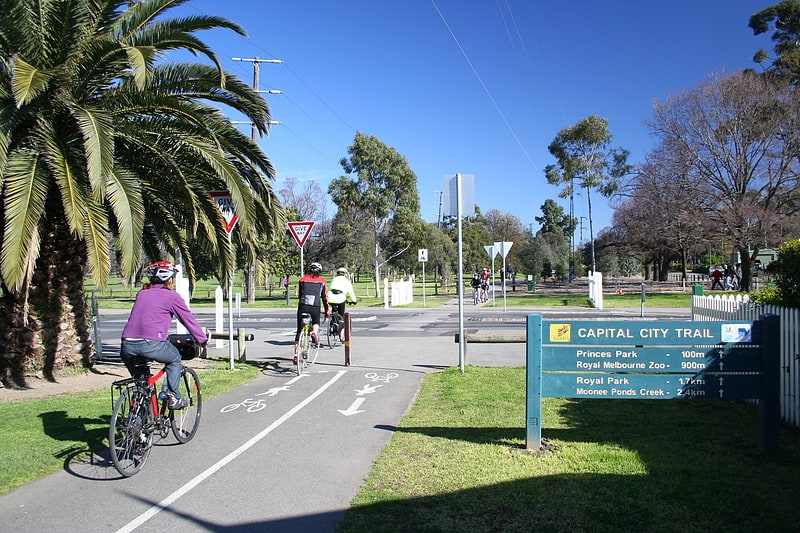
The Capital City Trail is a shared use path in Melbourne, Victoria, Australia, which circles the city centre and some inner eastern and northern suburbs. It is 29km in length, and mostly consists of sections of other trails, such as the Merri Creek Trail, Main Yarra Trail, Moonee Ponds Creek Trail and Inner Circle Rail Trail.
A popular starting point for the trail is at Princes Bridge near Flinders Street station. The rider can head off in an easterly or westerly direction. If heading off in the westerly, either side of the river can be used, but the south side tends to be more popular.
The Capital City Trail uses the same path as the Main Yarra Trail up to Dights Falls, where it continues, using the same path as the Merri Creek Trail, as part of its loop around the city.[26]
Address: Capital City Trail, Melbourne (City of Melbourne)
Albert Park and Lake
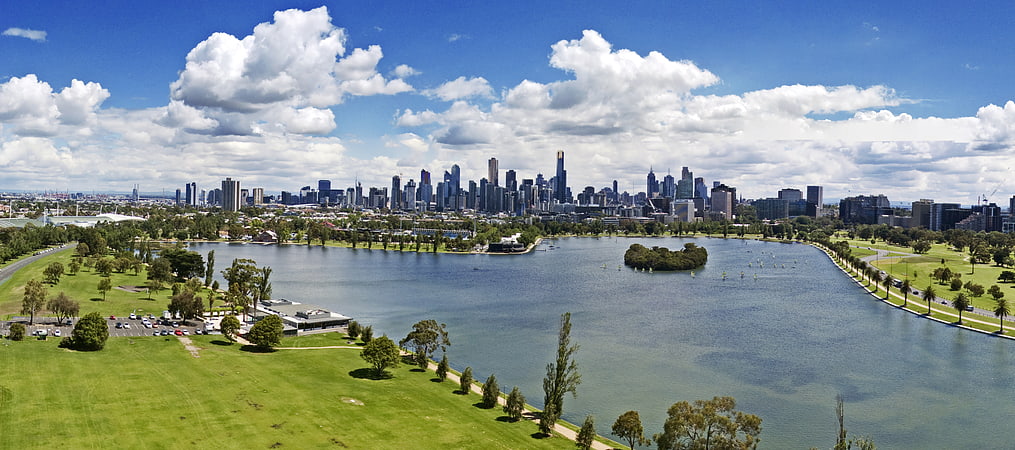
Lake in Australia. Albert Park and Albert Park Lake are situated in the City of Port Phillip, Victoria, Australia, 3 kilometres south of the Melbourne central business district.
The park encompasses 2.25 square kilometres (225 ha; 560 acres) of parkland including Albert Park Lake (0.49 square kilometres (49 ha; 120 acres)) and provides numerous ovals, sporting facilities, the Albert Park Public Golf Course, a 4.7-kilometre (2.9 mi) walking track around the lake, and the Albert Park Circuit. It is bordered by Albert Road, Queens Road, Fitzroy Street and Canterbury Road. Surrounding suburbs include Albert Park, Middle Park, St Kilda, Melbourne and South Melbourne.[27]
Address: Albert Park, Melbourne (Port Phillip)
Montsalvat
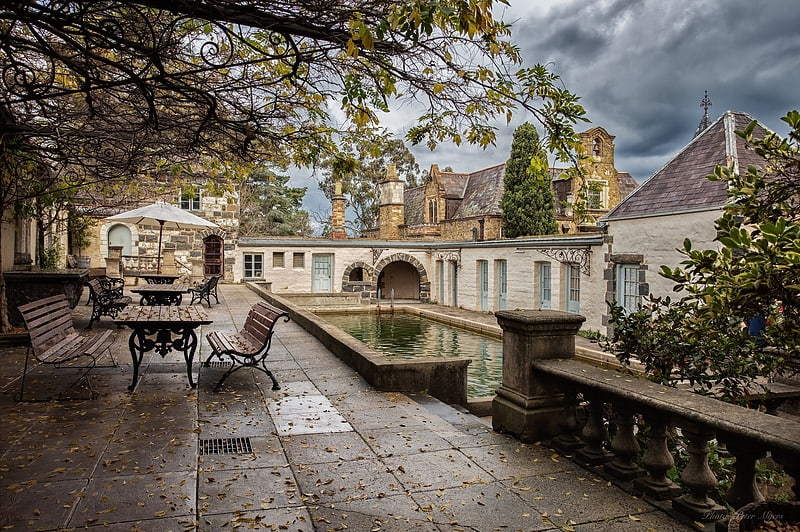
Art gallery in Eltham, Australia. Montsalvat is an artists' colony in Eltham, a suburb of Melbourne, Victoria, Australia. Established by Justus Jorgensen in 1934, the colony is set among gardens on five hectares of land, and is home to dozens of buildings, including houses, halls, studios, galleries and stables.
All of Montsalvat's buildings were designed and built by residents using materials from a variety of sources, including Victorian era buildings then being demolished in the city centre. The grounds and buildings are currently used for exhibitions, performances, conferences, seminars, weddings and receptions; however, artists working in a variety of mediums continue to reside in Montsalvat. Several classes on various disciplines of art are offered year round by the resident artists.
Today Montsalvat is a popular tourist attraction and the entire complex is listed on the Victorian Heritage Register.[28]
Address: 7 Hillcrest Ave, 3095 Eltham (Shire of Nillumbik)
Sandridge Bridge

Girder bridge in Melbourne, Australia. The Sandridge Bridge is a historic bridge, originally carrying a railway, over the Yarra River in Melbourne, Victoria, Australia. It runs diagonally to the river's banks and is 178.4 metres long. In 2006 it was redeveloped as a pedestrian and cycle path featuring public art. It is the third bridge on the site and is listed on the Victorian Heritage Register.[29]
Arts Centre Melbourne
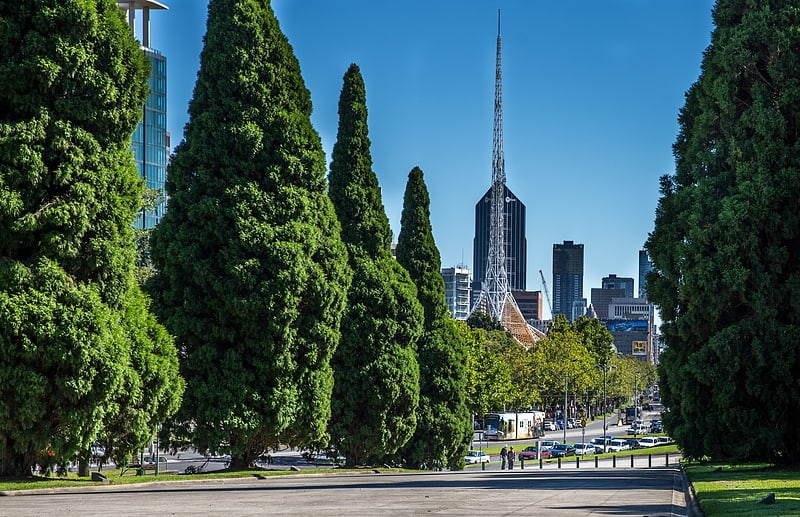
Performing arts centre in Southbank, Australia. Arts Centre Melbourne, originally known as the Victorian Arts Centre and briefly called the Arts Centre, is a performing arts centre consisting of a complex of theatres and concert halls in the Melbourne Arts Precinct, located in the central Melbourne suburb of Southbank in Victoria, Australia.
It was designed by architect Sir Roy Grounds, the masterplan for the complex (along with the National Gallery of Victoria) was approved in 1960 and construction began in 1973 following some delays. The complex opened in stages, with Hamer Hall opening in 1982 and the Theatres Building opening in 1984.
Arts Centre Melbourne is located by the Yarra River and along St Kilda Road, one of the city's main thoroughfares, and extends into the Melbourne Arts Precinct.
Major companies regularly performing include Opera Australia, The Australian Ballet, the Melbourne Theatre Company, The Production Company, Victorian Opera, Bell Shakespeare, Bangarra Dance Theatre and the Melbourne Symphony Orchestra. Arts Centre Melbourne also hosts many Australian and international performances and production companies.
Arts Centre Melbourne is listed on the Victorian Heritage Register.[30]
Address: 100 St Kilda Rd, 3004 Melbourne (City of Melbourne)
Brunswick Street

Street in Melbourne, Australia. Brunswick Street is a street in inner northern Melbourne, known for cafés, live music venues and alternative fashion shops.[31]
Jam Factory
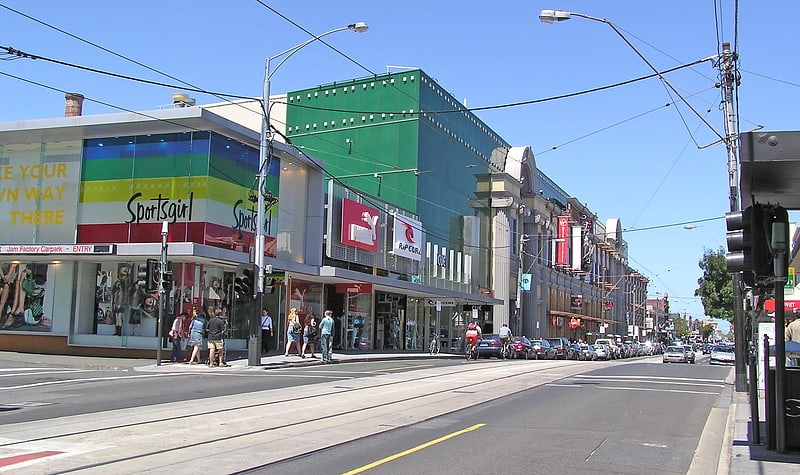
Shopping centre in South Yarra, Australia. The Jam Factory is a shopping and entertainment centre, located in Chapel Street, South Yarra, a suburb of Melbourne, Australia. The Jam Factory is owned by Newmark Capital Limited. It is also the headquarters of Village Roadshow.[32]
Address: 500 Chapel St, 3141 South Yarra (Stonnington)
Old Melbourne Gaol
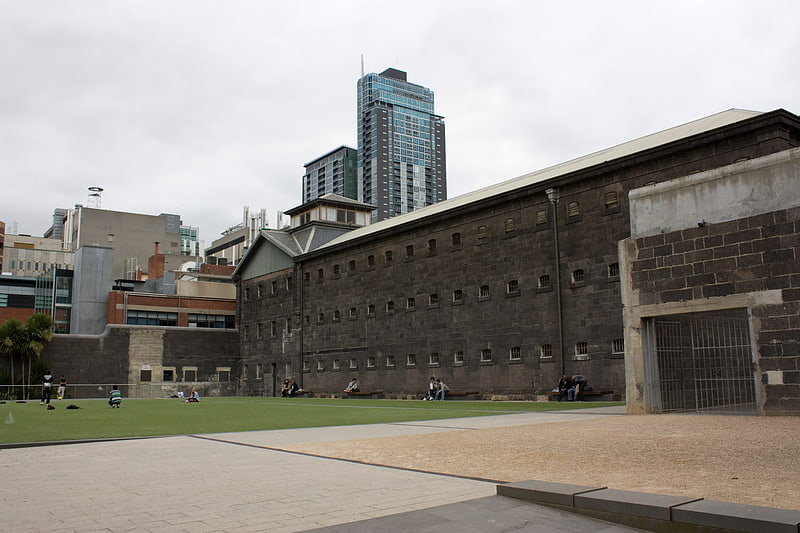
Museum in the City of Melbourne, Australia. The Old Melbourne Gaol is a former jail and current museum on Russell Street, in Melbourne, Victoria, Australia. It consists of a bluestone building and courtyard, and is located next to the old City Police Watch House and City Courts buildings, and opposite the Russell Street Police Headquarters. It was first constructed starting in 1839, and during its operation as a prison between 1845 and 1924, it held and executed some of Australia's most notorious criminals, including bushranger Ned Kelly and serial killer Frederick Bailey Deeming. In total, 133 people were executed by hanging. Though it was used briefly during World War II, it formally ceased operating as a prison in 1924; with parts of the jail being incorporated into the RMIT University, and the rest becoming a museum.
The three-storey museum displays information and memorabilia of the prisoners and staff, including death masks of the executed criminals. At one time the museum displayed what was believed at the time to be Ned Kelly's skull, before it was stolen in 1978; as well as the pencil used by wrongly convicted Colin Campbell Ross to protest his innocence in writing, before being executed.[33]
Address: 377 Russell St, 3000 Melbourne (City of Melbourne)
Fitzroy Gardens
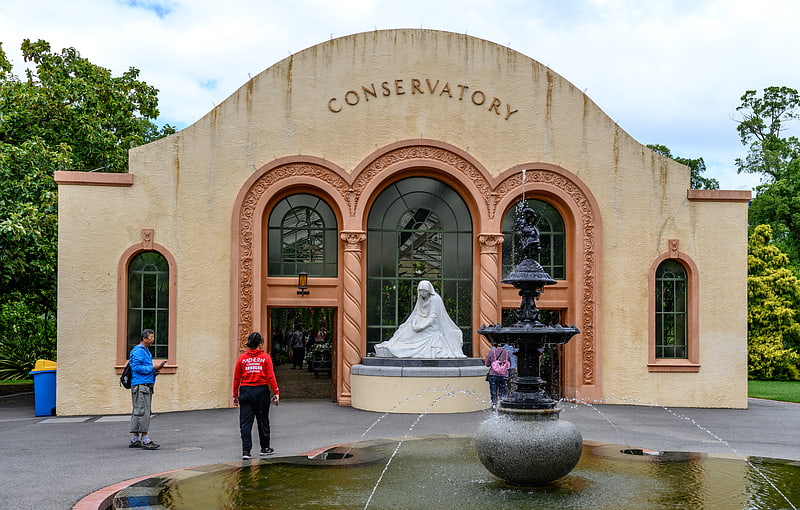
Garden in East Melbourne, Australia. The Fitzroy Gardens are 26 hectares located on the southeastern edge of the Melbourne Central Business District in East Melbourne, Victoria, Australia. The gardens are bounded by Clarendon Street, Albert Street, Lansdowne Street, and Wellington Parade with the Treasury Gardens across Lansdowne street to the west.
The gardens are one of the major Victorian era landscaped gardens in Australia and add to Melbourne's claim to being the garden city of Australia. Set within the gardens are an ornamental lake, a scarred tree, a visitor information centre and cafe, a conservatory, Cooks' Cottage (a house where the parents of James Cook lived, brought from England in the 1930s), tree-lined avenues, a model Tudor village, a band pavilion, a rotunda, the "Fairies' Tree", fountains and sculptures.[34]
Address: 230 Wellington Parade, 3002 Melbourne (City of Melbourne)
RMIT Melbourne City campus
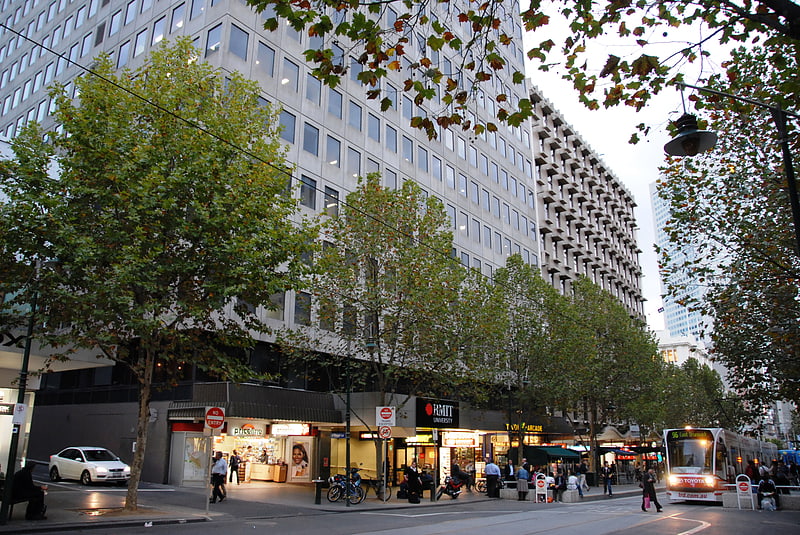
The Melbourne City campus of the Royal Melbourne Institute of Technology is located in the city centre of Melbourne in Victoria, Australia. It is sometimes referred to as "RMIT City" and the "RMIT Quarter" of the city in the media.[35]